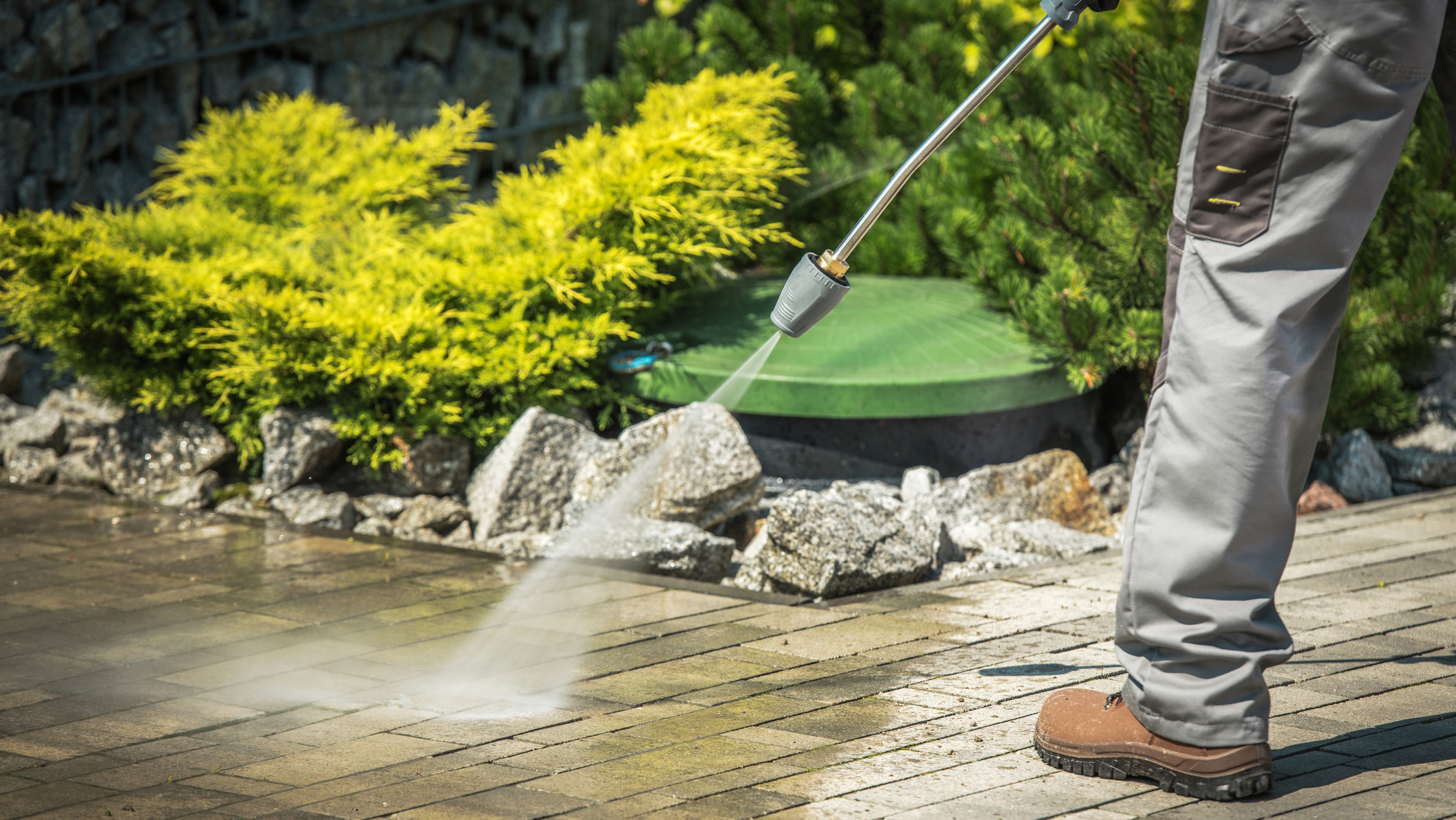How to use a pressure washer
Learn how to use a pressure washer to get your outdoor space looking fresh for summer.

A pressure washer could be your answer to taking the hard work out of sprucing up your outdoor spaces. Once you know how to use a pressure washer, you can easily clean driveways, patios, decking, fences, and even cars, all with minimal effort. In this guide, we’ll show you exactly how to tackle each one to save you hours of time by switching from hand washing to pressure washing.
There are many domestic appliances that make light work of cleaning the inside of your house, but have you considered that a pressure washer can do the same for your home’s exterior? All of your outdoor surfaces, from driveways to walls, are open to the elements and quickly accumulate dirt. Knowing how to use a pressure washer makes cleaning the outside spaces of your home a breeze.
Before we guide you through how to use a pressure washer, we’ll help you find the right type of pressure washer for your needs. Breaking this decision into simple pros and cons will help make sure that you don’t end up with a pressure washer that’s totally unsuited to your space, as even the best pressure washers can be a dud if they don’t work for you.
Different types of pressure washers
When buying a pressure washer, your first big decision will be what type of fuel source you want it to run on: electric or gas. Both have benefits and drawbacks, so it’s important you choose what’s best for you.
Power
Gas-powered pressure washers tend to be a lot more powerful, with higher PSI output (pounds per square inch; the measurement of water pressure). The more powerful the pressure washer, the more difficult it is to control, requiring skill and strength to handle. Consider whether you feel comfortable handling a more powerful piece of equipment.
Maintenance
Sign up to receive the latest news, reviews, buying guides and deals direct to your inbox
Ask yourself what level of general maintenance you’re comfortable with performing on your pressure washer. For a gas-powered pressure washer, oil is used to cool the motor and pump, so you’ll need to keep it topped up to the right level and change over the oil and gasoline filters roughly once a year. Electric pressure washers don’t require this kind of maintenance.
Noise
Electric pressure washers tend to be noticeably quieter, running at about 80db, whereas gas pressure washers run at approximately 100-120db. To put this into context, 85db is the level at which safety professionals advocate wearing ear defenders to protect against hearing loss.
Portability
Instagram and TikTok gardening expert, Nathan Stafford, says, “If you decide to use an electric pressure washer then please make sure you have safety waterproof cables to avoid any serious accidents and try to keep the cables away from any areas where you are working.”
Gas pressure washers are cordless and therefore more portable than electric pressure washers. Think about whether the outdoor space you’re cleaning is large enough for portability to a factor in which pressure washer you purchase.
If you do decide to use an electric pressure washer, it’s important to always be mindful of your power cord. Garden care expert, Nathan Stafford, uses pressure washers to achieve a great clean on any grimy surfaces in his clients’ outdoor spaces. He documents his work on his TikTok account @nathanslawnsandgardens where he currently has 1.1 million viewers who watch along with his transformations. He gives us a pro tip to use safety waterproof cables to use a pressure washer with a cord safely. This is an important consideration when purchasing extension cables to hook your pressure washer up to the inside.
How to get started
Now that you have a machine that’s right for you, you’re ready to learn the art of how to use a pressure washer. Start by dressing appropriately for the task. Not sure what you need to stay safe and dry?
Our expert Nathan Stafford explains what personal safety equipment is essential:
"Of course, safety is important and wearing safety glasses is a must due to the amount of debris that can fly up towards your eyes. Overall as long as you wear steel-capped boots, sturdy Gumboots, and keep your feet out of the way by always working in front of yourself then you are good to go.”
As well as sturdy boots and protective eyewear we suggest that you wear clothes with long sleeves and full pant legs that you don’t mind getting wet and dirty during work.
Before firing up your oil pressure washer, remember to fill it up with engine oil and gasoline. For an electric pressure washer, ensure that you plug your machine into an earthed outlet as far away from the area you are working on as you can get it. Run water through your machine for a minute to clean the line out. Next, read on for our instructions on how to use a pressure washer on any of your outdoor spaces in need of a refresh.
How to clean decking and fences with a pressure washer
Keeping decking and fences clean is not only a great way to spruce up your outdoor space but also prevents mold and mildew from taking hold of the wood and ultimately rotting them. Follow these simple steps to learn how to use a pressure washer to clean decking or fences:
- Firstly move any planters or decorative items out of the way to prevent breakage.
- For fences, work in sections, firstly wetting the fencing or decking down all over and power washing off any surface level debris such as leaves, moss, or dirt using a nozzle spray of 5-10cm.
- Next, use a wood-specific detergent working from top to bottom of each panel to avoid it dripping down and visible streaks being left. Allow the detergent to work on tough, set-in staining and dirt for approximately 5-10 minutes.
- Wash off the detergent using a rotating brush attachment all over to eliminate stuck in grime and heavy stains.
- Remember to do a final rinse to ensure all detergent is rinsed off. A wide fan style spray action should help to cover as much surface area as quickly as possible.
- For decking, repeat the above steps except instead of working from top to bottom, work in the direction away from your house so that any dirty water runs away from your property.
How to clean a patio or driveway with a pressure washer
Patios and driveways are especially susceptible to moss and weeds. Once you know how to use a pressure washer to clean them, you can save yourself a lot of weeding by hand. Spruce up your driveways and patios with this method:
- Start by brushing away loose matter such as leaves, twigs, stones, and dirt. Using a pressure washer would cause this kind of debris to fly up at speed, potentially hurting people or damaging property.
- Set your pressure washer to between 1200 PSI to an absolute maximum of 2300 to avoid damaging the stone or tarmac of the surface material.
- Spray the area away from your property so that the runoff water flows away from your house or garage. When working with a driveway you ideally want the water to run into a drain. At this stage use a 5-10 cm nozzle spray which is fairly focussed to blast away weeds and moss.
- Sluice the area with detergent and wait for 5-10 minutes to allow the detergent to work on stained areas and deep-set mud or oil.
- Spray the area again with a fan-style nozzle spray to wash away the detergent and any remaining grime.

How to clean a car with a pressure washer
Cleaning a car with a pressure washer can easily eliminate stubborn dirt however it’s extremely important to properly understand how to use a pressure washer to clean a car before you do so to avoid damage. The crucial thing to know is that using a pressure washer with pressure that’s too high can chip the paintwork!
To make sure that this doesn’t happen to you, select a pressure washer with a PSI of 1200-1900. Any setting above this could cause damage. Follow the rest of the steps below to ensure a sparkling clean:
- If your nozzle has a variable spray size, adjust it to be 5-10cm wide. This width should be strong enough to blast off loose dirt but not so intense that it damages the paint.
- Stand at least a meter away to avoid getting sprayed and then spray the car’s exterior all over to shift any loose dirt and dust.
- Apply a reputable car detergent all over the car. Most pressure washers have a specific detergent tank for this purpose. Use the widest nozzle setting to distribute it gently and evenly.
- Don’t set the detergent sit, as this could cause corrosion or blemishes. Rinse off using a brush attachment on the nozzle if you have one. This should help to loosen up any set in oil or grime. Do the wheel arches last in case there are any loose stones caught in there - you don’t want to rub stones against your paintwork!
- Rinse the car all over again with the stronger 5-10cm spray to get rid of any final dirt that the detergent has loosened.
What not to clean with a pressure washer
Now that you know how to use a pressure washer for so many useful outdoor cleaning tasks you might think that there’s nothing around the home that it can’t clean. Unfortunately, there are important exceptions to take note of to stay safe and prevent annoying and expensive problems later. We explain the key things on your property not to pressure wash.
- Windows: As tempting as it might seem to reach high windows and speed up the job, most household windows simply aren’t able to take the pressure and could shatter inwards.
- Gutters: Unfortunately pressure washers aren’t suitable to clear out guttering, as the force can easily cause the guttering to come loose and fall down.
- Roof shingles: Using a pressure washer on asphalt shingles can strip off the texture from the shingle, break the shingle entirely and leak water into the house around the shingles. Cleaning shingles with a pressure washer is simply a recipe for water damage.
- Brickwork with old, crumbling mortar: Pressure washing is usually fine on new brickwork or brickwork in sturdy condition but be wary of using it on crumbling brickwork. Where the mortar is already unstable the pressure could break it up further.
- Stained wood e.g. painted furniture or stained decking: Using a pressure washer on a pressure that’s too high and a nozzle spray that is too intense could strip the paint or stain off of woodwork. We suggest washing painted woodwork by hand.
Discover more guides for the garden…
Tanisha started her career in commercial retail buying for one of Amazon UK’s Top 10 revenue grossing online homeware retailers. Years spent obsessing over homeware products made it an easy career switch to writing about them. Her freelance career has seen her craft customer-focused web content for brands big and small, as well as writing articles in the health, lifestyle, home and retail sectors.

